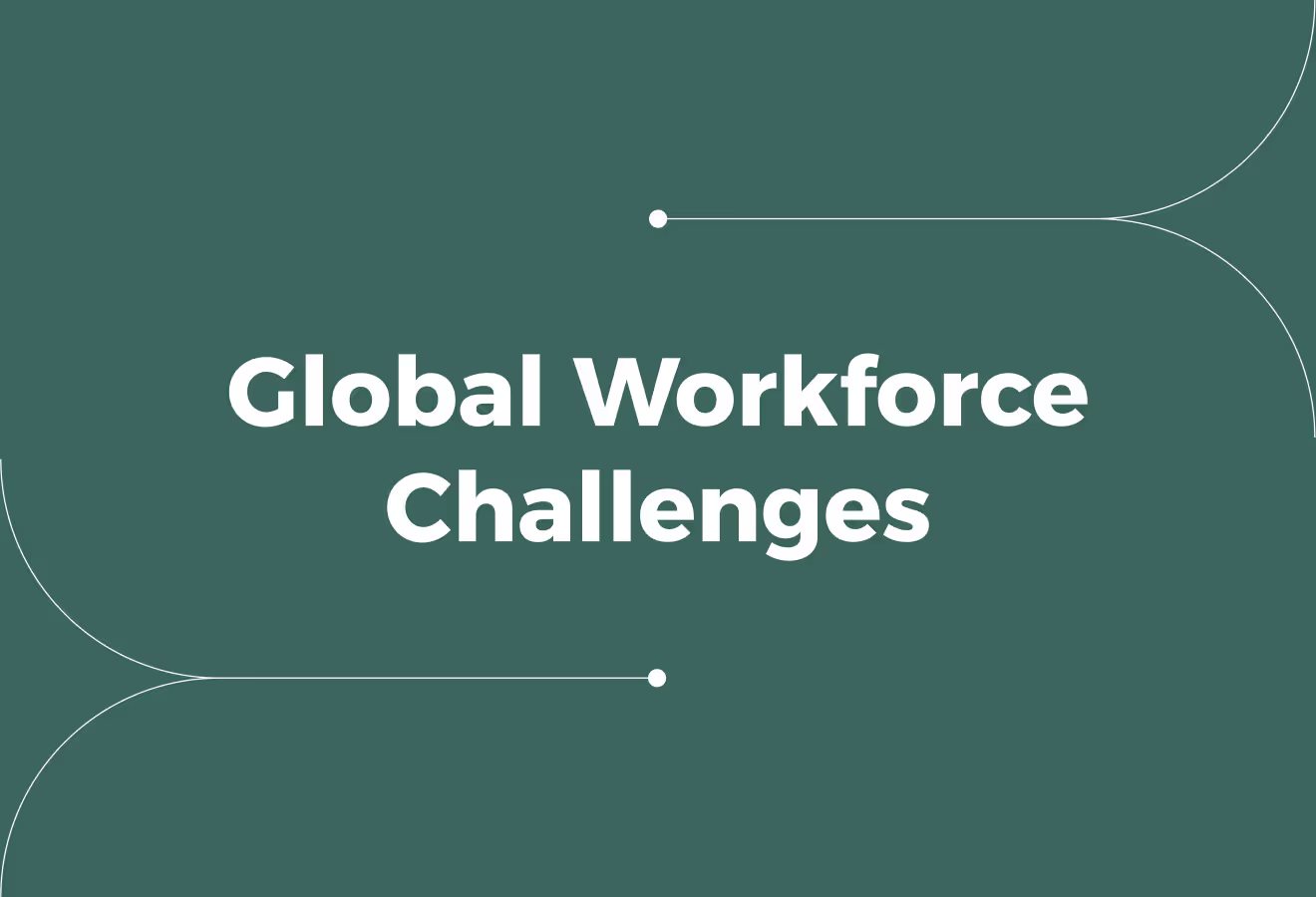Challenges Of Managing A Global Workforce & Solutions To Mitigate Them

Challenges Of Managing A Global Workforce & Solutions To Mitigate Them
Managing a global workforce is like conducting an orchestra, each section plays a vital role, yet brings unique complexities. HR professionals must navigate diverse expectations, regulations, and cultures across international teams.
The best Employer of Record companies go beyond logistics, tackling compliance, cross-border payroll, time zone coordination, and cultural nuances to keep operations running smoothly and employees engaged. To simplify these challenges, our global HR system helps businesses manage international teams more efficiently, streamlining compliance, payroll, and communication across multiple countries and cultures.
What is Global Workforce Management?

Global workforce management refers to the strategic approach companies use to manage employees across different countries and regions. It involves recruiting, managing, and retaining talent from a global talent pool while ensuring compliance with local labour laws, cultural nuances, and international regulations.
As businesses expand internationally, managing a diverse and geographically dispersed workforce becomes more complex. A strong global workforce management strategy enables companies to optimise talent, maintain operational efficiency, and support business growth on a global scale.
According to Deloitte, companies with robust global workforce management strategies are better equipped to handle the challenges of operating in multiple countries, ensuring they attract the right talent while mitigating risks related to compliance and cross-border operations.
With globalisation reshaping the modern business landscape, managing a global workforce effectively is critical for success. PwC highlights that companies need to create tailored strategies for managing employees in different cultural contexts, while also adapting to varying local laws and regulations. As international markets continue to grow, organisations must embrace diverse workforce management practices to stay competitive.
Related Reading
Benefits of a Global Workforce for Organisations

Hiring a global workforce promotes diversity, which leads to better business performance. For instance, having a diverse team allows for different perspectives and approaches to problem-solving. Instead of relying on a homogenous way of thinking, an organisation can develop a more multifaceted approach to tackling challenges. This not only boosts creativity and innovation, but it can also improve the bottom line.
Accessing a Larger Pool of Talent
Hiring a global workforce promotes diversity, which leads to better business performance. For instance, having a diverse team allows for different perspectives and approaches to problem-solving.
Instead of relying on a homogenous way of thinking, an organisation can develop a more multifaceted approach to tackling challenges. This not only boosts creativity and innovation, but it can also improve the bottom line.
Explore the Top 10 HR Software Solutions UAE & MENA to support a diverse team.
Building a Global Workforce for International Expansion
No matter where a business is located, there's always the possibility of discovering stronger talent beyond the local market. Hiring internationally opens access to a significantly larger pool of candidates with the specialised skills and experience required for organisational growth.
Global hiring is especially valuable for companies in regions facing skill shortages. It also offers strategic advantages for businesses based in high cost-of-living areas, where finding top-tier talent in lower-cost jurisdictions can help reduce hiring expenses without compromising quality.
Cercli's Gratuity Calculator Saudi Arabia can help project future liabilities when hiring in new regions, providing critical financial foresight for global expansion.
Cutting Down On Hiring Costs
Expanding into a new international market can be accelerated by building a global workforce. Whether an organisation hires remote employees or establishes an international office staffed with local talent, having people on the ground in the target market provides valuable insights into the local business culture and operational practices.
This on-the-ground presence significantly contributes to shaping a well-informed market entry strategy and helps avoid costly missteps. Learn more about how to hire globally to support expansion goals.
One of the most surprising benefits of global hiring is the potential to reduce your organisation’s overall hiring costs. The process of recruiting, onboarding, and paying employees comes with many hidden costs that can create a significant financial burden for businesses. By hiring internationally, you can mitigate some of these costs. For example, working with a global HR and payroll platform can help you streamline the process of hiring employees in other countries. This can reduce the time and money spent on onboarding while also ensuring compliance with local labour laws.
Cercli simplifies global workforce management for companies in the Middle East looking to expand internationally. Our global HR system helps organisations reduce the costs of hiring and managing employees in other countries by streamlining global payroll and ensuring compliance with local labour laws.
Related Reading
- Payroll Outsourcing Costs
- Payroll and Compliance Challenges
- Payroll Internal Controls Best Practices
Challenges of Managing a Global Workforce

One of the most significant challenges in managing a global workforce is navigating cultural differences. Employees from diverse cultural backgrounds bring distinct beliefs, values, communication styles, and work ethics.
These differences can lead to the following challenges:
- Misunderstandings: Simple miscommunications due to cultural variances can lead to significant misunderstandings. For example, a direct communication style preferred in some Western cultures may be perceived as rude by individuals from more indirect communication cultures.
- Conflict: Different cultural norms and practices can cause friction among team members. For instance, differing attitudes towards hierarchy and authority can lead to conflicts in decision-making processes.
- Integration Issues: Integrating employees into a cohesive team becomes challenging when cultural barriers create invisible walls between team members.
Communication Barriers The Language Divide
Language differences can pose significant challenges in communication. Misunderstandings due to language barriers can affect productivity and collaboration among team members.
Key issues caused by language barriers include:
- Misinterpretation: Key messages and instructions can be lost or misinterpreted, leading to errors and inefficiencies.
- Slow Communication: Language barriers can slow down the pace of communication, making it difficult to meet deadlines and respond quickly to issues.
- Exclusion: Employees who are not fluent in the dominant language may feel excluded from conversations and decision-making processes.
Time Zone Differences The Scheduling Nightmare
Managing an international workforce often means dealing with employees located in different time zones. This can complicate scheduling meetings, coordinating tasks, and ensuring timely communication.
The following points summarise the main ideas:
- Scheduling Conflicts: Finding mutually convenient times for meetings can be challenging, often resulting in some team members having to join outside their regular working hours.
- Delayed Responses: Time zone differences can lead to delays in responses and decision-making, impacting project timelines.
- Work-Life Balance Issues: Employees may struggle to maintain a healthy work-life balance if they are required to attend meetings or work outside their regular hours frequently.
Legal and Regulatory Compliance: The Fine Print
Each country has its own set of labour laws and regulations. Managing an international workforce requires compliance with diverse legal requirements, which can be complex and time-consuming.
Key challenges include:
- Varying labour laws: Different countries have unique labour laws regarding working hours, employee benefits, termination procedures, and more. Keeping up with these varying regulations can be overwhelming.
- Taxation issues: International employees may be subject to different tax laws, requiring complex payroll and tax management.
- Data protection laws: Ensuring compliance with varying data protection regulations, such as GDPR in Europe, can be challenging, especially when handling employee data across borders.
Technological Challenges The Digital Divide
Each country has its own set of labour laws and regulations. Managing an international workforce requires compliance with diverse legal requirements, which can be complex and time-consuming.
The following points summarize the main ideas:
- Varying labour Laws: Different countries have unique labour laws regarding working hours, employee benefits, termination procedures, and more. Keeping up with these varying regulations can be overwhelming. For instance, labour laws in the UAE mandate employees be paid through WPS. These requirements differ significantly from those in other parts of the world.
- Taxation Issues: International employees may be subject to different tax laws, requiring complex payroll and tax management.
- Data Protection Laws: Ensuring compliance with varying data protection regulations, such as GDPR in Europe, can be challenging, especially when handling employee data across borders. Use HR Policies in UAE: 2025 Compliance Cheat Sheet to stay ahead of regulatory changes.
Employee Engagement and Retention
Engaging and retaining employees in an international workforce can be challenging due to cultural differences, communication barriers, and varying expectations.
Key challenges include:
- Isolation: Remote employees may feel isolated and disconnected from the team, leading to lower engagement and productivity.
- Differing Expectations: Employees from different cultures may have varying expectations regarding recognition, career progression, and work-life balance, making it challenging to maintain consistent engagement.
- Retention Issues: High turnover rates can be a problem if employees feel their cultural and personal needs are not being met.
Best Practices for Managing a Global Workforce

Engaging and retaining employees in an international workforce can be challenging due to cultural differences, communication barriers, and varying expectations.
Cultures Are Different - Learn About Them
Cultural ignorance can cause serious missteps with global employees and damage a business’s reputation. Overseas employees are part of a distinct community, and working for a foreign company can create cultural tension or discomfort if not addressed thoughtfully.
Understanding their culture, history, and even basic language improves communication and supports more effective management. Approaching employees’ cultural backgrounds with humility can foster trust and morale.
For example, acknowledging and celebrating important cultural dates with employees shows respect and inclusivity. Learning about different cultures not only boosts employee performance but also enhances a company’s reputation within local communities.
Know the Employment Laws That Apply to Your International Employees
Every country has its own unique set of employment laws, which dictate how businesses should treat their workers. Ignorance of these regulations can lead to serious legal trouble for the company. Before hiring global talent, it's important to research and understand the crucial employment laws that apply to international employees. These include regulations concerning contracts, termination, benefits, and leave. Understanding these laws can help manage a global team fairly and ensure compliance, which in turn earns employees’ trust and respect.
Communication Is Key to Managing a Global Workforce
When managing a global workforce, effective communication is vital. First, there’s the issue of language barriers. Even if English is the common language, employees might not understand certain expressions, slang, or jargon.
Cultural differences also affect how people interpret words and gestures. Communication should be approached with care, aiming for clarity and objectivity. Observing team members’ reactions is essential—if they appear confused or uncomfortable, a culturally inappropriate term may have been used.
Schedule Team Bonding Activities
Achieving company goals is feasible when everyone is on the same page. To support this alignment, it’s important to encourage cohesion within the team.
Team bonding activities are a highly effective method for building cohesion within an international team. These include fun and interactive experiences such as games and collaborative group projects.
Since international workforces often collaborate virtually, consider organising virtual team bonding activities. There is a wide array of online games for multiple players. Some of these games require team effort, naturally encouraging interaction between co-workers.
Beyond promoting teamwork, employee engagement has been linked to greater professionalism. A Gallup study reveals that engaging employees in such activities can reduce absenteeism by 41%.
To maintain these benefits, schedule team bonding activities at least once a year.
Encourage Cultural Awareness
Respecting each other’s cultures within the organisation enhances positive communication and seamless collaboration. Encouraging cultural awareness within your workforce helps build mutual understanding and trust.
Meeting with the HR team to discuss programs or workshops can support employees in understanding and appreciating the diverse backgrounds of their colleagues.
Find Solutions to Time-zone-related Challenges
One of the significant challenges of hiring a global team is the difference in time zones. Automation and advanced communication systems ensure communication remains possible across borders.
However, there are times when emergency meetings or team bonding activities require real-time interaction. To ensure full participation, it's essential to address time zone differences proactively.
Creating a recurring schedule, such as a monthly period for live meetings, can help build consistency. Managers should gather input from employees to accommodate various time zones while acknowledging that having everyone present simultaneously is nearly impossible.
Consider offering two or three different meeting times to encourage broader participation and flexibility while respecting team members' availability.
Use Employee Management Technology
Managing an international workforce would be almost impossible without employee management systems. These tools help streamline oversight of daily activities, facilitate team communication, and track productivity.
Essential tools include time trackers, internal messaging systems, and payroll software. From an employer’s perspective, attendance and time management are among the most vital.
According to Statista, about 88% of employers use time and attendance management tools to monitor their workers’ activities during working hours. Some time management software even allows visibility into an employee’s screen during work hours.
Additional insights on workplace culture and satisfaction can be found in this Gallup article.
Related Reading
- AI Tools for HR
- Employer of Record vs PEO
- Global EOR
- Remote Global Payroll
Book a Demo to Speak with Our Team about Our Global HR System
Expanding your workforce across borders can help your company grow and become more resilient. However, the complexities of managing a globally dispersed team can be daunting. Cercli simplifies this process for companies in the Middle East with its employer of record services. Cercli helps businesses manage their entire workforce, whether local or spread across 150+ countries, all in one platform.
Companies can run fully compliant payroll across the UAE, Saudi Arabia, and the wider MENA region, manage leave, onboard employees, track assets, and handle global contractor payments in multiple currencies with ease. Whether you’re managing 25 employees or scaling to 500+ across multiple markets, Cercli combines deep local expertise with global capabilities, giving your HR team one simple, compliant system to run operations and pay your workforce anywhere.










